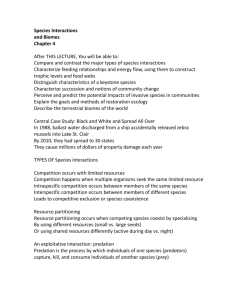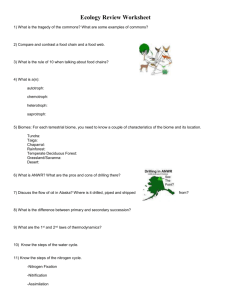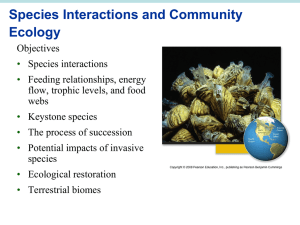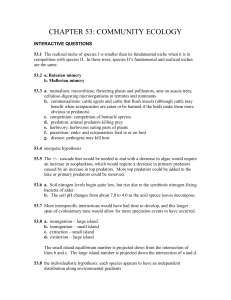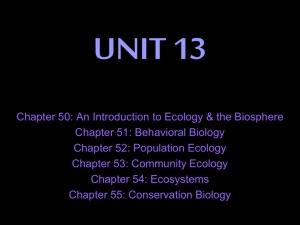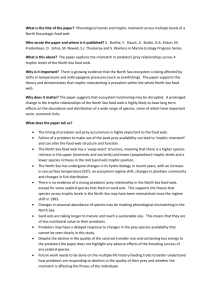Chapter 4: Species Interactions and Community Ecology
advertisement
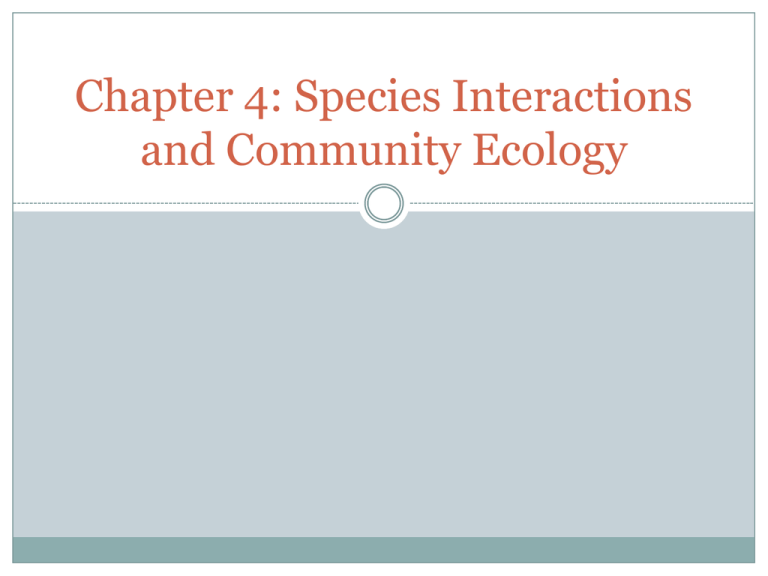
Chapter 4: Species Interactions and Community Ecology Central Case Study: Black and White and Spread All Over In 1988, discharged ship ballast water accidentally released zebra mussels into Lake St. Clair By 2010, they had spread to 30 states No natural predators, competitors, or parasites They cause millions of dollars of property damage each year Species interactions Species interactions are the backbone of communities Effects of species interactions on the participants: Type of interaction Effect on Species 1 Effect on Species 2 Competition – – Predation, parasitism, herbivory + – Mutualism + + “+”: positive effect “–”: negative effect Competition occurs with limited resources Competition: multiple organisms seek the same limited resource Food, water, space, shelter, mates, sunlight, etc. Intraspecific competition: between members of the same species High population density: increased competition Interspecific competition: between members of different species Strongly affects community composition Leads to competitive exclusion or species coexistence Results of interspecific competition Competition is usually subtle and indirect One species may exclude another from using the resource Zebra mussels displaced native mussels in the Great Lakes Quagga mussels are now displacing zebra mussels Or, competing species may be able to coexist Natural selection favors individuals that use different resources or shared resources in different ways Resource partitioning Resource partitioning: competing species coexist by specializing By using different resources (small vs. large seeds) Or using shared resources differently (active during day vs. night) An exploitative interaction: predation • Exploitation: one member benefits while the other is harmed (+/- interactions) – Predation, parasitism, herbivory Predation: process by which individuals of one species (predators) capture, kill, and consume individuals of another species (prey) Predation affects the community Interactions between predators and prey structure food webs The number of predators and prey influences community composition Predators can, themselves, become prey Zebra mussels eat smaller types of zooplankton Zebra mussels are prey for North American predators (fish, ducks, muskrats, crayfish) Predation can drive population dynamics Increased prey populations increase food for predators Predators survive and reproduce Increased predator populations decrease prey Predators starve and their populations decrease Decreased predator populations increase prey populations Insert Fig. 4.4 Predation has evolutionary ramifications Natural selection leads to evolution of adaptations that make predators better hunters Individuals who are better at catching prey: Live longer, healthier lives Take better care of offspring Prey face strong selection pressures—they are at risk of immediate death Prey develop elaborate defenses against being eaten Prey develop defenses against being eaten An exploitative interaction: parasitism Parasitism: a relationship in which one organism (parasite) depends on another (host) For nourishment or some other benefit The parasite harms, but doesn’t kill, the host • Some parasites contact hosts infrequently – Cuckoos, cowbirds • Some live within the host – Disease, tapeworms • Some live on the hosts’ exterior – Ticks, sea lampreys Parasite – host relationships Parasitoids: insects that parasitize other insects Kill the host Example: wasp larvae burrow into, and kill, caterpillars Coevolution: hosts and parasites become locked in a duel of escalating adaptations Has been called an evolutionary arms race Each evolves new responses to the other It may not be beneficial to the parasite to kill its host An exploitative interaction: herbivory Herbivory: animals feed on the tissues of plants Widely seen in insects May not kill the plant But affects its growth and reproduction Defenses against herbivory include: Chemicals: toxic or distasteful Thorns, spines, or irritating hairs Herbivores may overcome these defenses Mutualists help one another Two or more species benefit from their interactions Each partner provides a service the other needs (food, protection, housing, etc.) Symbiosis: a relationship in which the organisms live in close physical contact (mutualism and parasitism) Microbes within digestive tracts Mycorrhizae: plant roots and fungi Coral and algae (zooxanthellae) Pollination: bees, bats, birds, and others transfer pollen from one flower to another, fertilizing its eggs Pollination • In exchange for the plant nectar, the animals pollinate plants, which allows them to reproduce Ecological communities Community: an assemblage of populations of organisms living in the same area at the same time Members interact with each other Interactions determine the structure, function, and species composition of the community Community ecologists are interested in how: Species coexist and interact with one another Communities change, and why these patterns exist Energy passes among trophic levels One of the most important species interactions Who eats whom? Matter and energy move through the community Trophic levels: rank in the feeding hierarchy Producers (autotrophs) Consumers Detritivores and decomposers Producers: the first trophic level Producers, or autotrophs (“self-feeders”): organisms capture solar energy for photosynthesis to produce sugars Green plants Cyanobacteria Algae They capture solar energy and use photosynthesis to produce sugars Consumers: consume producers • Primary consumers: second trophic level Organisms that consume producers Herbivorous grazing animals Deer, grasshoppers Secondary consumers: third trophic level Organisms that prey on primary consumers Wolves, rodents, birds Tertiary consumers: fourth trophic level Predators Hawks, owls Detritivores and decomposers Organisms that consume nonliving organic matter Detritivores: scavenge waste products or dead bodies Millipedes, soil insects Decomposers: break down leaf litter and other nonliving material Fungi, bacteria Enhance topsoil and recycle nutrients Energy, biomass, and numbers Most energy that organisms use in cellular respiration is lost as waste heat Less and less energy is available in each successive trophic level Each trophic level contains only 10% of the energy of the trophic level below it There are also far fewer organisms and less biomass (mass of living matter) at the higher trophic levels A human vegetarian uses less energy and has a smaller ecological footprint than a meat eater Pyramids of energy, biomass, and numbers Food webs show relationships and energy flow Food chain: a series of feeding relationships Food web: a visual map of feeding relationships and energy flow among organisms Food webs are greatly simplified and leave out most species Some organisms play big roles Keystone species: has a strong or widereaching impact Far out of proportion to its abundance Removing a keystone species has substantial ripple effects Alters the food web Large-bodied secondary or tertiary consumers Species can change communities Trophic cascade: predators at high trophic levels indirectly promote populations at low trophic levels By keeping species at intermediate trophic levels in check Extermination of wolves led to increased deer populations … Which overgrazed vegetation … Which changed forest structure Ecosystem engineers: physically modify the environment Beaver dams, prairie dogs, ants Communities respond to disturbances Communities experience many types of disturbance Removal of keystone species, natural disturbances (fires, floods, etc.) Human impacts cause major community changes Resistance: a community resists change and remains stable despite the disturbance Resilience: a community changes in response to a disturbance, but later returns to its original state Or, a community may never return to its original state Primary succession Succession: the predictable series of changes in a community After a severe disturbance Primary succession: disturbance removes all vegetation and/or soil life Glaciers, drying lakes, volcanic lava covering the land Pioneer species: the first species to arrive in a primary succession area Lichens: fungi + algae Secondary succession Secondary succession: a disturbance has removed much, but not all, of the biotic community Fires, hurricanes, logging, farming Aquatic systems can also undergo succession Ponds eventually fill in to become terrestrial systems Climax community: remains in place with few changes Until another disturbance restarts succession Communities may undergo shifts Community changes are more variable and less predictable than early models of succession suggested Conditions at one stage may promote another stage Competition may inhibit progression to another stage Chance factors also affect changes Phase (regime) shift: the overall character of the community fundamentally changes Some crucial threshold is passed, a keystone species is lost, or an exotic species invades Example: overfishing and depletion of fish and turtles has allowed algae to dominate coral reef communities Invasive species threaten stability Alien (exotic) species: non-native species from somewhere else enters a new community Invasive species: non-native species that spreads widely and become dominant in a community Introduced deliberately or accidentally Growth-limiting factors (predators, disease, competitors, etc.) are absent Major ecological effects Pigs, goats, and rats have destroyed island species But some invasive species (e.g., honeybees) help people Invasive mussels modify communities Controlling invasive species Techniques to control invasive species include: Removing them manually Applying toxic chemicals Drying them out, depriving them of oxygen Introducing predators or diseases Stressing them with heat, sound, electricity, carbon dioxide, or ultraviolet light Control and eradication are hard and expensive Prevention, rather than control, is the best policy Altered communities can be restored Humans have dramatically changed ecological systems Severely degraded systems cease to function Restoration ecology: the science of restoring an area to an earlier (presettlement) condition Tries to restore the system’s functionality (e.g., filtering of water by a wetland) Ecological restoration: actual efforts to restore an area Difficult, time-consuming, and expensive It is best to protect natural systems from degradation in the first place Examples of restoration efforts Prairie restoration: replanting native species, controlling invasive species, controlled fire to mimic natural fires The world’s largest project: Florida Everglades Flood control and irrigation removed its water Populations of wading dropped 90–95% It will take 30 years and billions of dollars to restore natural water flow birds Widely separated regions share similarities Biome: major regional complex of similar communities recognized by: Plant type Vegetation structure There are about 10 terrestrial biomes Abiotic factors influence biome locations The type of biome depends on temperature, precipitation Also air and ocean circulation, soil type Climatographs: a climate diagram showing an area’s mean monthly temperature and precipitation Similar biomes occupy similar latitudes Aquatic systems have biome-like patterns Various aquatic systems comprise distinct communities Coastlines, continental shelves, open ocean, deep sea Coral reefs, kelp forests Some coastal systems (estuaries, marshes, etc.) have both aquatic and terrestrial components Aquatic systems are shaped by Water temperature, salinity, dissolved nutrients Wave action, currents, depth, light levels Substrate type Animals, not plants, delineate marine communities Temperate deciduous forest Deciduous trees lose their broad leaves each fall They remain dormant during winter Midlatitude forests in Europe, east China, eastern North America Even, year-round precipitation Fertile soils Forests: oak, beech, maple Temperate grasslands More temperature difference Between winter and summer Less precipitation supports grasses, not trees Also called steppe or prairie Once widespread, but has been converted to agriculture Bison, prairie dogs, groundnesting birds, pronghorn Temperate rainforest U.S. coastal Pacific Northwest Heavy rainfall Coniferous trees: cedar, spruce, hemlock, fir Moisture-loving animals Banana slug Erosion and landslides affect the fertile soil Most old-growth is gone as a result of logging Tropical rainforest Southeast Asia, west Africa Central and South America Year-round rain and warm temperatures Dark and damp Lush vegetation Diverse species But in low densities Very poor, acidic soils Nutrients are in the plants Tropical dry forest Also called tropical deciduous forest Plants drop leaves during the dry season India, Africa, South America, north Australia Wet and dry seasons Warm, but less rainfall Converted to agriculture Severe soil erosion Savanna Tropical grassland interspersed with trees Africa, South America, Australia, India Precipitation occurs only during the rainy season Animals gather near water holes Zebras, gazelles, giraffes, lions, hyenas Desert Minimal precipitation Sahara: bare, with sand dunes Sonoran: heavily vegetated Temperatures vary widely Day vs. night, seasonally Soils (lithosols): high mineral content, low organic matter Animals: nocturnal, nomadic Plants: thick skins, spines Tundra Russia, Canada, Scandinavia Minimal rain, very cold winters Permafrost: permanently frozen soil Residents: polar bears, musk oxen Migratory birds, caribou Lichens, low vegetation, no trees Alpine tundra: on mountaintops Boreal forest (taiga) Canada, Alaska, Russia, Scandinavia A few evergreen tree species Cool and dry climate Long, cold winters Short, cool summers Nutrient poor, acidic soil Moose, wolves, bears, lynx, migratory birds Chaparral Occurs in small patches around the globe Mediterranean Sea, Chile, California, south Australia Densely thicketed, evergreen shrubs Highly seasonal biome Mild, wet winters Warm, dry summers Fire-resistant plants Conclusion Species interactions affect communities Competition, predation, parasitism, competition, mutualism Causing weak and strong, direct and indirect effects Feeding relationships are represented by trophic levels and food webs Humans have altered many communities Partly by introducing non-native species Ecological restoration attempts to undo the negative changes that we have caused
